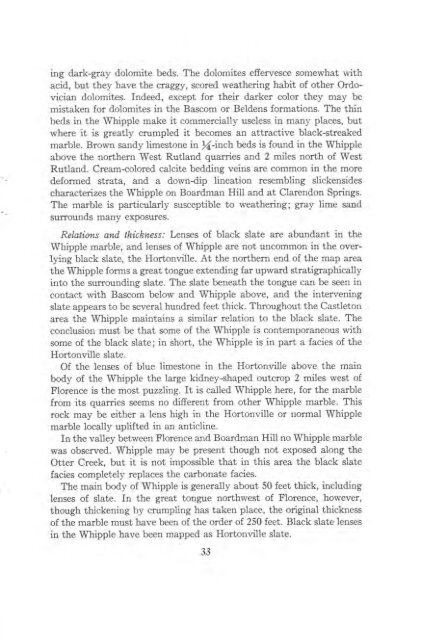STRATIGRAPHY AND STRUCTURE CASTLETON AREA VERMONT
STRATIGRAPHY AND STRUCTURE CASTLETON AREA VERMONT
STRATIGRAPHY AND STRUCTURE CASTLETON AREA VERMONT
You also want an ePaper? Increase the reach of your titles
YUMPU automatically turns print PDFs into web optimized ePapers that Google loves.
ing dark-gray dolomite beds. The dolomites effervesce somewhat with<br />
acid, but they have the craggy, scored weathering habit of other Ordovician<br />
dolomites. Indeed, except for their darker color they may be<br />
mistaken for dolomites in the Bascom or Beldens formations. The thin<br />
beds in the Whipple make it commercially useless in many places, but<br />
where it is greatly crumpled it becomes an attractive black-streaked<br />
marble. Brown sandy limestone in h-inch beds is found in the Whipple<br />
above the northern West Rutland quarries and 2 miles north of West<br />
Rutland. Cream-colored calcite bedding veins are common in the more<br />
deformed strata, and a down-dip lineation resembling slickensides<br />
characterizes the Whipple on Boardman Hill and at Clarendon Springs.<br />
The marble is particularly susceptible to weathering; gray lime sand<br />
surrounds many exposures.<br />
Relations and thickness: Lenses of black slate are abundant in the<br />
Whipple marble, and lenses of Whipple are not uncommon in the overlying<br />
black slate, the Hortonville. At the northern end of the map area<br />
the Whipple forms a great tongue extending far upward stratigraphically<br />
into the surrounding slate. The slate beneath the tongue can be seen in<br />
contact with Bascom below and Whipple above, and the intervening<br />
slate appears to be several hundred feet thick. Throughout the Castleton<br />
area the Whipple maintains a similar relation to the black slate. The<br />
conclusion must be that some of the Whipple is contemporaneous with<br />
some of the black slate; in short, the Whipple is in part a facies of the<br />
Hortonville slate.<br />
Of the lenses of blue limestone in the Hortonville above the main<br />
body of the Whipple the large kidney-shaped outcrop 2 miles west of<br />
Florence is the most puzzling. It is called Whipple here, for the marble<br />
from its quarries seems no different from other Whipple marble. This<br />
rock may be either a lens high in the Hortonville or normal Whipple<br />
marble locally uplifted in an anticline.<br />
In the valley between Florence and Boardman Hill no Whipple marble<br />
was observed. Whipple may be present though not exposed along the<br />
Otter Creek, but it is not impossible that in this area the black slate<br />
facies completely replaces the carbonate facies.<br />
The main body of Whipple is generally about 50 feet thick, including<br />
lenses of slate. In the great tongue northwest of Florence, however,<br />
though thickening by crumpling has taken place, the original thickness<br />
of the marble must have been of the order of 250 feet. Black slate lenses<br />
in the Whipple have been mapped as Hortonville slate.<br />
33













